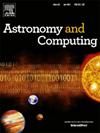From global climate models (GCMs) to exoplanet spectra with the Global Emission Spectra (GlobES)
IF 1.8
4区 物理与天体物理
Q2 ASTRONOMY & ASTROPHYSICS
引用次数: 0
Abstract
In the quest to understand the climates and atmospheres of exoplanets, 3D global climate models (GCMs) have become indispensable. The ability of GCMs to predict atmospheric conditions complements exoplanet observations, creating a feedback loop that enhances our understanding of exoplanetary atmospheres and their environments. This paper discusses the capabilities of the Global Exoplanet Spectra (GlobES) module of the Planetary Spectrum Generator (PSG), which incorporates 3D atmospheric and surface information into spectral simulations, offering a free, accessible tool for the scientific community to study realistic planetary atmospheres. Through detailed case studies, including simulations of TRAPPIST-1 b , TRAPPIST-1 e, and Earth around Sun, this paper demonstrates the use of GlobES and its effectiveness in simulating transit, emission and reflected spectra, thus supporting the ongoing development and refinement of observational strategies using the James Webb Space Telescope (JWST) and future mission concept studies (e.g., Habitable Worlds Observatory [HWO]) in exoplanet research.
从全球气候模式(GCMs)到具有全球发射光谱(GlobES)的系外行星光谱
为了了解系外行星的气候和大气,3D全球气候模型(GCMs)已经变得不可或缺。gcm预测大气条件的能力与系外行星观测相补充,形成了一个反馈回路,增强了我们对系外行星大气及其环境的理解。本文讨论了行星光谱发生器(PSG)的全球系外行星光谱(GlobES)模块的功能,该模块将三维大气和地表信息纳入光谱模拟,为科学界研究真实的行星大气提供了一个免费的、可访问的工具。通过详细的案例研究,包括对TRAPPIST-1 b、TRAPPIST-1 e和地球绕日的模拟,本文展示了GlobES的使用及其在模拟凌日、发射和反射光谱方面的有效性,从而支持詹姆斯·韦伯太空望远镜(JWST)观测策略的持续发展和完善,以及未来任务概念研究(如宜居世界天文台[HWO])在系外行星研究中的应用。
本文章由计算机程序翻译,如有差异,请以英文原文为准。
求助全文
约1分钟内获得全文
求助全文
来源期刊

Astronomy and Computing
ASTRONOMY & ASTROPHYSICSCOMPUTER SCIENCE,-COMPUTER SCIENCE, INTERDISCIPLINARY APPLICATIONS
CiteScore
4.10
自引率
8.00%
发文量
67
期刊介绍:
Astronomy and Computing is a peer-reviewed journal that focuses on the broad area between astronomy, computer science and information technology. The journal aims to publish the work of scientists and (software) engineers in all aspects of astronomical computing, including the collection, analysis, reduction, visualisation, preservation and dissemination of data, and the development of astronomical software and simulations. The journal covers applications for academic computer science techniques to astronomy, as well as novel applications of information technologies within astronomy.
 求助内容:
求助内容: 应助结果提醒方式:
应助结果提醒方式:


